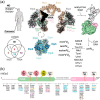How Elongator Acetylates tRNA Bases
- PMID: 33152999
- PMCID: PMC7663514
- DOI: 10.3390/ijms21218209
How Elongator Acetylates tRNA Bases
Abstract
Elp3, the catalytic subunit of the eukaryotic Elongator complex, is a lysine acetyltransferase that acetylates the C5 position of wobble-base uridines (U34) in transfer RNAs (tRNAs). This Elongator-dependent RNA acetylation of anticodon bases affects the ribosomal translation elongation rates and directly links acetyl-CoA metabolism to both protein synthesis rates and the proteome integrity. Of note, several human diseases, including various cancers and neurodegenerative disorders, correlate with the dysregulation of Elongator's tRNA modification activity. In this review, we focus on recent findings regarding the structure of Elp3 and the role of acetyl-CoA during its unique modification reaction.
Keywords: Elongator; Elp3; acetyl-CoA; cancers; neurodegenerative diseases; proteome balance; tRNA modification.
Conflict of interest statement
The authors declare no conflict of interest.
Figures



References
Publication types
MeSH terms
Substances
Grants and funding
LinkOut - more resources
Full Text Sources
Miscellaneous

